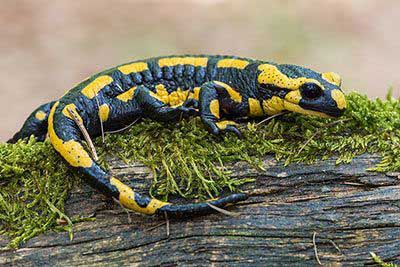The 24-hour ant (or bullet ant) causes pain that lasts for 24 hours.
The African bullfrog sometimes attacks lions.
An ant can survive for two days under water.
One anteater will polish off around 30,000 ants and termites in a day.
The Arctic fox can survive temperatures of -58 Fahrenheit (-50 degrees Celsius).
The armadillo’s “armor” is made from soft, leathery skin.
The common basilisk (a small lizard) can run across water.
One bat can eat 1,200 insects in an hour.
Bats are the only mammals that can fly.
Beavers can hold their breath for 45 minutes.
Bees can see ultraviolet light.
There are over 400,000 different kinds of beetle.
Birds chew with their stomachs.
Birds save energy by flying in a V shape.
Only 3 animals have blue tongues: giraffes, Chow Chows and blue-tongued skinks.
A blue whale drinks 17,000 gallons (64,500 l) of water in one gulp.
The buff-tailed bumblebee feeds on around 4,500 flowers each day - a regular bee only needs 150.
Butterflies usually have around 12,000 eyes.
Butterflies taste with their feet.
Camargue horses also graze under water.
A cat spends 10,950 hours of its life dozing.
A cat has 32 muscles in its ear.
A house cat spends 70 % of its life asleep.
Cat urine glows under a blacklight.
A caterpillar has around 3,200 muscles more than a human.
Most cats won’t be hurt if they fall 30 ft (9 m).
Cheetahs can change direction mid-jump.
Chickens can’t swallow upside down.
The Chihuahua was named after the Mexican state of Chihuahua.
Chihuahuas often snore because of their short noses.
To make sure that cleaner fish can find parasites easily, the bignose unicorn fish turns pale.
1 gram of cobra venom can kill 16,000 mice, 150 dogs or 80 people.
A cockroach can survive without its head for 9 days.
Crocodiles can’t chew.
The saltwater crocodile can live to be over 100 years old.
Crocodiles swallow stones so they can dive deeper.
Crocodiles can’t stick their tongues out.
Desert lizards dance across the sand when it gets too hot.
If you blow into a dog’s ear, you can damage its hearing.
Dolphins can be white, pearl, pink, brown, gray, blue and black.
There are pink dolphins in the Amazon.
Dolphins can jump over 25 ft (7 m) out of the water.
Dolphins have up to 250 teeth.
Donkeys can see all four of their feet at the same time.
Dragonflies can see in all directions at the same time.
An eagle has around 7,000 feathers.
Eels have two hearts.
An elephant can live to be up to 70 years old.
One elephant tooth can weight more than 6 lb (almost 3 kg).
Elephants grow their whole lives long.
Elephants are the only animals that can’t jump.
Lake flies flap their wings over 1,000 times a second.
Flying tree snakes fly from tree to tree.
Foxes sometimes live in one burrow with badgers, rabbits and owls.
Baby giraffes fall almost 6 ft (2 m) to the ground after being born.
Giraffes are the only animals born with horns.
Goats have square-shaped pupils.
The goldfish is actually a small carp.
The oldest goldfish in the world lived to be 43.
Grasshoppers hear using their front legs.
One human year is 25 hamster years.
Herrings communicate by passing gas.
650 houseflies weigh less than a Kinder chocolate bar.
At 46 - 68 mph (75 - 110 km/h), the Indo-Pacific sailfish is the fastest short-distance fish.
There are over one million kinds of insect.
A jellyfish is made up of over 98 % water.
Jellyfish venom still works if the jellyfish is dead.
Kangaroos can’t go backwards.
Kiwis are the only birds that can smell.
Koalas are very good swimmers.
The Norwegian Lundehund has six toes on its paws and can close its ears.
A mole can dig 300 ft (more than 90 m) in one night.
Mosquitoes have 47 teeth.
Mouse teeth are almost as hard as diamond.
Naked mole-rats are said to be able to tunnel through concrete.
Orangutans burp just before they attack.
An ostrich brain only weighs 1.4 oz (40 g).
An owl’s eyes are bigger than its brain.
Pandas like doing somersaults.
Pandas are good at climbing and swimming.













